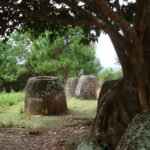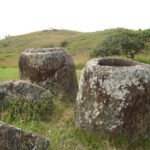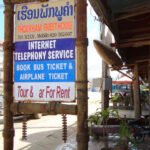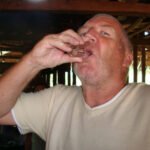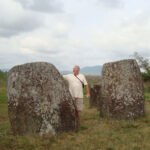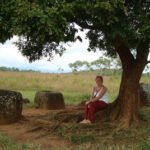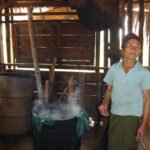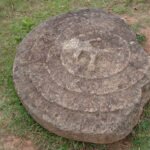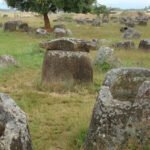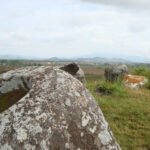Two Backpacks
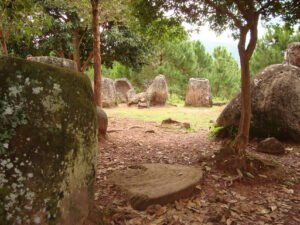
Chapter 23 - The Mystical Plain of Jars, Phonsavan
We’re on our way to Phonsavan, our minibus gradually filling with locals as we progress into the mountains above Vang Vieng.
I lean from the open bus window and enjoy the breeze, fascinated by the scenes that come into view at every bend in the road. Houses with matted or wooden walls and thatched roofs huddle together along the way. Children play in the caked, dry earth, the youngest wearing only T-shirts, their little bottoms jiggling as they walk.
It’s an impoverished existence high in the hills. Where nearly every home has a satellite dish in Vang Vieng and the surrounding towns, the higher our bus takes us, the fewer dishes we see. A donkey and cart is the primary mode of transport; very few cars are on the road.
Instead, hens, cockerels and chicks slow our passage, scurrying around in the undergrowth. Water buffalo and cattle wander freely, meandering out of our way as they somehow recognise the sound of our approach. On one stretch of road, our driver swerves to miss four ducklings asleep on the warm asphalt.
The views over distant mountains, bathed in sunlight and shade, are breathtaking. The road hugs the hillside, zig-zagging back and forth, hairpin after hairpin, the steep banks reminding me of those back home in Somerset and Devon, where small streams trickle through the undergrowth, and ferns sprout from precariously balanced rocks.
I breathe in the clean, sweet air and smile.
Beside me, Ron has managed to perch his computer on his lap and is happily tapping away at the keys, oblivious to the beauty around us.
‘Look, Ron! Isn’t the view magnificent?’
He lifts his head from his screen and glances out of the window.
‘Hmmm,’ is all he says in agreement before returning to whatever he’s doing.
The scenery changes. Gone is the dense forest, replaced by mile after mile of rice fields. We seem to be on a plateau.
Our driver stops in a village for lunch. Ron and I follow him into a small hut and order two colas and what I can only describe as a Laos pasty – folded corn dough with an unfamiliar filling.
‘Do you think there’s a loo?’ I ask Ron.
We glance around the sparsely furnished room. There are no other doors except the one we walked through when we entered.
‘Doesn’t look like it,’ replies Ron. ‘Go and ask.’
For some reason, Ron believes I can speak any language we might need on our journey. I’ve no idea why!
In desperate need, I target our bus driver in the hope he might be able to understand something of what I’m asking. I walk over to where he’s seated and tap him on the shoulder.
‘Is there a toilet?’ I ask, slowing my speech in the vain hope that he’ll understand me.
He looks at me quizzically.
‘Toilet?’ I repeat, dreading what I know comes next.
There’s no recognition of what I’m asking.
I’ll have to run for the bushes if I don’t find a toilet soon. There’s nothing for it. I squat and repeat, ‘Toilet?’
A smile gradually spreads across the driver’s face. He leaves his table, walks outside and points to a solitary tiny tin shack on the other side of the yard.
I’m at the shack’s door in seconds. As I yank it open, a stomach-churning stench hits; before me lies a shallow hole encompassed by a ring of filthy, uneven stones. With no alternative, I take a deep breath, then rush in and do what I must.
Outside again, I gasp for air while trying to compose myself.
‘Alright?’ asks Ron when I sit back at our table.
‘If you need to pee, use the bushes,’ I reply before taking a glug of cola.
Our helpful driver indicates that it’s time to be on the move again.
We pay for our lunch and climb onboard the bus along with six other passengers. It’s another four long hours before we reach Phonsavan.
It’s twilight when we exit the bus and shoulder our backpacks.
‘Let’s grab a beer at that café across the road. It looks like there are a few other travellers. Maybe someone can recommend a place to stay tonight,’ suggests Ron.
We talk to two Australians, Therese and Cameron, waiting for their night bus to Vientiane.
‘We stayed at the White Orchid. It’s clean and cheap, plus they do a good breakfast, all for eight dollars Australian. It’s a great deal,’ Cameron advises.
While I leave to see if the White Orchid has a room for the night, Ron, Therese and Cameron order more beer.
Most of the properties appear rather old and worn.
Luckily, the White Orchid is in one of the newer blocks. The owner shows me the room, and we agree on eight dollars for the night.
Back at the café, I have another beer with our newfound friends, and then Ron and I head off. We both need an early night, especially as we’re up at six the following morning to join the excursion to The Plain of Jars.
There are six of us on the tour bus the following morning, a German couple, two English girls, Ron and me. Our guide, Peter, speaks excellent English and explains where we’re going and some of the site’s history.
‘Xieng Khouang Plain, or The Plain of Jars, is one of Southeast Asia’s most important prehistoric sites. A megalithic landscape dating from 500 BC to AD 500, it consists of thousands of stone jars, one to three metres in height and weighing up to fourteen tonnes. To date, no one knows their purpose.’
He pauses for any questions before continuing, ‘Laos was heavily bombed during the Vietnamese War. American airstrikes disrupted the supply route used by the North Vietnamese – the Ho Chi Minh Trail. Phonsavan, in particular, was heavily hit.’
‘Please, watch where you’re walking; remain on the designated pathways and do NOT stray off the signed paths,’ implores Peter. ‘Bombies, bombs that look like balls and shower hundreds of lethal ball bearings when detonated, still cover the area we’re visiting.
‘Many of the jars survived, and MAG, a British mine-clearing organisation, cleared the site we’re visiting today.’
It’s a clear, bright morning; sunshine dances over tall grass fields while birds call from the shade of trees dotted across the landscape. The tranquillity is deceptive. Peter instructs us again to be careful where we walk.
We spot the first jars as we climb a nearby hillside. I stand and take in the spectacle before me; giant grey stone vessels chiselled from a nearby quarry scatter the ground as far as the eye can see.
‘Look over there, Ron. That one’s got a lid!’ I exclaim, spotting one of the few jars to retain its cover.
I’m about to inspect it when Ron grabs my arm.
‘What are you doing? You can’t go running around! Remember what Peter said about bombs! Don’t be such an idiot!’
In my excitement, I’d forgotten Peter’s warnings.
‘I didn’t think!’ I mumble, embarrassed by my stupidity.
Taking Ron’s hand, we continue to explore together, keeping to the well-worn paths.
‘I wonder what they were used for? Water? Food storage?’ I say to no one in particular as I try to work out a pattern for the placement of these giant stones or at least an explanation for their existence.
‘If the experts can’t find an answer, I’m not sure you can!’ replies Ron with a wry smile.
‘But it’s fun trying to work it out. Look over there,’ I continue. ‘Some of them are round while others have a squarish shape. I wonder if they put bodies in them?’ I muse as I stop beside a jar taller than me.
Before we leave the site, Peter leads us to a cave carved into the hillside.
‘This is where local villagers hid and sheltered when the Americans bombed the area. They lived here for over three years with no running water or food apart from what they could scavenge from the fields,’ Peter explains before continuing. ‘In another cave, four hundred villagers were killed by a rocket attack.’
Reminders of the Vietnam War are everywhere, whether it’s the remains of a cave, the empty munition shells that line Phonsavan’s streets or the warning signs indicating unexploded bombs.
To cheer us up, our guide offers to take us to a local village where lao lao, a rice whiskey, is made.
A middle-aged woman greets us on the porch of her white-painted, wooden house. She’s dressed in a faded blue shirt and green sarong; her welcoming smile shows betel nut stained red teeth and gums. She leads us to where the rice is fermented with yeast and water in metal drums and proudly shows us the room where her ‘still’ is located.
‘It takes about twenty days to make,’ explains Peter. ‘Would you like to try some?’
‘Stupid question!’ Ron murmurs. ‘Bet it’s not as good as Scottish whiskey.’
The women in our group go first. We’re each given a tot of the clear liquid.
‘You have to down it in one!’ Peter insists.
I, together with my fellow female companions, happily oblige. I can feel a glow as the liquid slides down my throat; it’s delicious!
Then it’s the turn of the two men. Ron goes first and downs his in one.
‘Not bad,’ he confirms with a smile.
The woman says something in Lao, and Peter interprets. ‘She wants to know if you’d like another?’
We all have another two drinks each. For some reason, the woman has taken a liking to Ron and insists on refilling his glass. After four drinks, Ron calls a halt.
Our return trip to Phonsavan is much livelier thanks to the generosity of the friendly whiskey maker!
We pay for another night’s accommodation at the White Orchid and retire to our room after an early supper.
Relaxing on the narrow double bed, I let my thoughts return to the day’s trip.
‘It’s difficult to imagine those magnificent, mystical jars laying in those fields for nearly two thousand years,’ I muse.
It appears Ron’s thinking along the same lines. ‘I know, he replies. ‘It’s also amazing they survived the American bombing that went on in the area. Perhaps the ancient gods are protecting them.’
‘There’s a strange but comforting contrast around this town,’ I continue. ‘On the one hand, there are still daily reminders of the horror war brings, the terrible stories of children picking up those bombies and maimed for life, but then there’s the beautiful tranquillity and generosity of the people who live here. I’m so pleased we made the effort to come.’
Ron snuggles me to him. ‘Me too,’ he whispers.
**********
To learn more about MAG (Mine Advisory Group), go to Home | MAG (maginternational.org)
To read more about their work in Laos, visit MAG removes 300,000th unexploded bomb in Laos – Lao People’s Democratic Republic (the) | ReliefWeb
